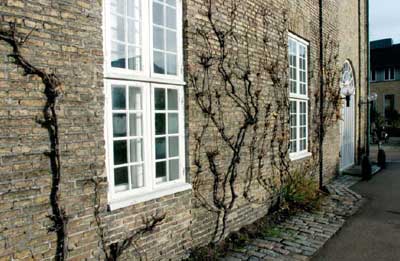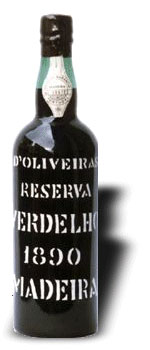|
You are here: 4Naval Life & Humor4Index4Saving the Madeira Wine |
|||||||||||||||||||||||||||
|
Saving the Madeira Wine (1874):How two Danish Navy Cadets secured future Wine Production during a visit to MadeiraAccording to the writer, the Danish Navy had a hand in making it possible that we still today can enjoy a glass of Madeira wine. I will leave it to the reader to decide whether this story actually holds water. Similar stories are circulated in the British and Dutch navies, but fact is that the vines continue to grow in Kuglegaarden and on Nyholm, in Copenhagen. …And of course on Madeira, as well.
The vines continue to thrive in Kuglegaarden,
even though they appeared a little bare when the photo was taken in December,
2006. By Commander Benny G. Larsen Many have heard the story about the Danish navy's rescue of Madeira's famous wine, but only a very few are actually aware of the details behind this event which took place more than a hundred years ago. The first export of wine from Madeira is known to have happened as early as 1561. Until World War 1, during which the Danish West India colonies, St. Jan, St. Croix, and St. Thomas were sold to the United States in 1917 for the sum of $ 25 million, the Danish Navy always had a warship stationed in the Caribbean. On the return voyage from the Caribbean it was customary to call at the island of Madeira, where the West India frigate, as the ship was known, anchored in the roads of Funchal. There were two reasons for the call, partly to re-provision with fresh fruit and water and partly to provide the officers with several casks of Madeira's famous product, the excellent Madeira wine. Wine for the social events during winter The officers did not only procure wine for their own use but they also bought some casks for the Naval Officer's and Petty Officer's associations to provide a good and tasty wine for the winter’s social events. The "triangular" navigation continued for decades. In the spring when the ice broke up in the Danish straits and sounds, the West India frigate set sail towards the Virgin Islands in the Caribbean. During fall, when the winter in Denmark approached, the course was shaped toward Europe, only interrupted by a short call at Madeira. As soon as the provisions, including the wine, was stowed on board, the voyage towards Denmark was quickly resumed to make it home before the straits and sounds were closed by ice. During this last leg of the voyage, the homeward bound frigate would often meet its outward bound replacement, the other West India frigate.
In the period 1849-1852 some sort of a fungus largely destroyed the vineyards of Madeira. However, a few vines escaped the disease and the wine production resumed already in 1855. But within 20 years a new disaster would hit the wine industry. In the beginning of the 1870's, a west India frigate called once again at Madeira. A couple of the frigate's cadets went ashore and "lifted" a few vines from a vineyard. The vines were put into a bucket filled with sand and placed in the frigate's sail locker where the spare sails are kept. The sensitive vines were carefully nursed by the two cadets and thrived in the warm sail locker. When the frigate arrived in Copenhagen some months later, the two cadets proudly displayed the live vines. Part of the vines were planted in a south facing garden at Nyboder (the Danish Navy's housing development for officers) where it was well protected against the chilly winds. It survived very well and after a couple of years, produced lovely blue Madeira grapes. The remaining vine, according to the story, was planted at Nysoe Manor on Praestoe, where it also thrived and the blue Madeira grapes are produced to this day. Disaster strikes Madeira again Disaster again hit Madeira's wine industry in 1873. A year earlier, a vicious disease had struck at the European vineyards. The disease, which was caused by lice, also arrived in Madeira, where it quickly spread and practically destroyed all the vines on the island. The growers were keen to resume wine making. And new vines were imported from America, but with less than satisfactory result. It was just not the same as the blue Madeira grape. Meanwhile, a Danish diplomat happened to visit Funchal during this time. The diplomat used to be an officer in the Danish Navy, and he happened to have served on board the West India frigate where the two cadets had brought the vines on board. Hearing about the crisis in the Madeira vineyards he recalled what had happened years ago. A message to the Admiralty The diplomat reported his observations to the Admiralty in Copenhagen. The Admiralty reported back that the blue Madeira grapes were still growing very well in the garden of the Nyboder house close to St Paul's church. Some of the vines from Nyboder were send to Madeira where they quickly grew into a new wine industry. Nyboder was not the only place in Denmark where attempts to grow the famous Madeira grape were successfully made. Vine was planted by the south facing wall of the old arsenal building in Kuglegaarden on Holmen (Denmark's naval base then). Here the vine was well protected against the northern and western winds. The vine thrived so well that in a few years it produced the lovely blue and sweet Madeira grape. Thus today, practically all Madeira wine is made from grapes imported from Denmark. Translated by J. D. Nielsen
- Do you miss a major event on this Site,
Are you able to contribute to the unfolding of
the Danish Naval History, You can also use the Naval Web Forum on this web-site.
|
- |
|||||||||||||||||||||||||
|
|
|||||||||||||||||||||||||||
|
This page was last updated: - This page was first published: September 19, 2007 |
|||||||||||||||||||||||||||
|
Copyright © 2013-2016 Johnny E. Balsved - All rights reserved - Privacy Policy |
|||||||||||||||||||||||||||


 The "Lifting" of a few vines
The "Lifting" of a few vines